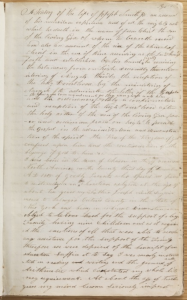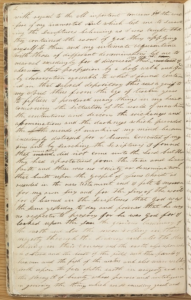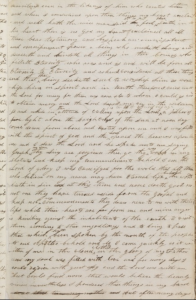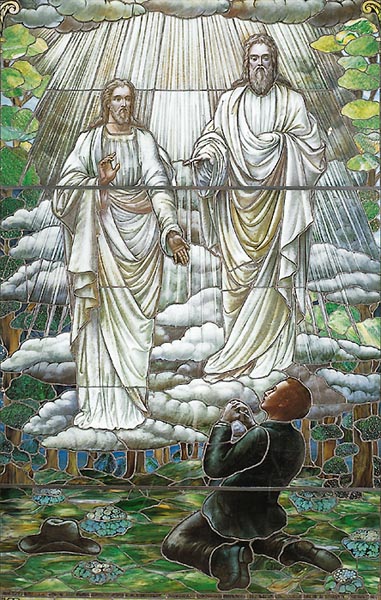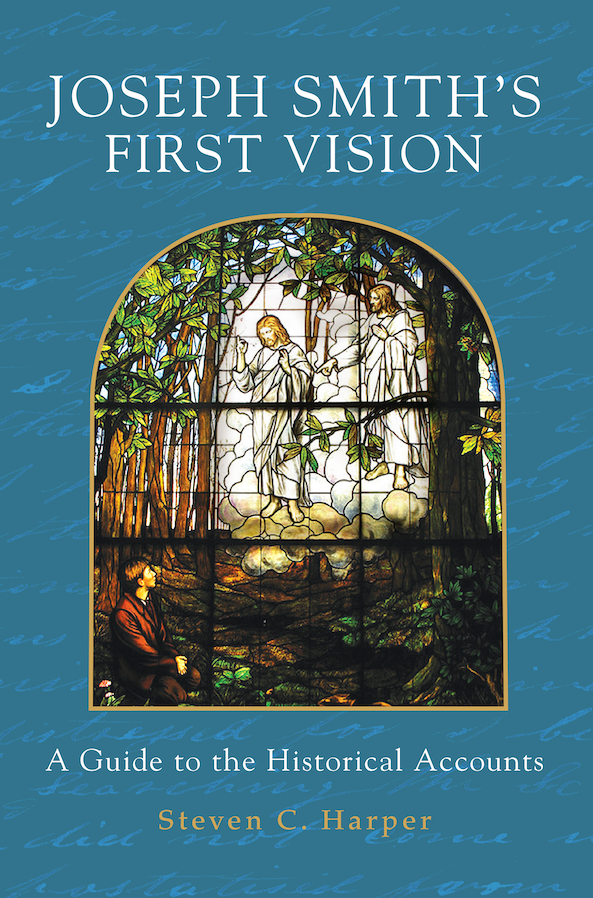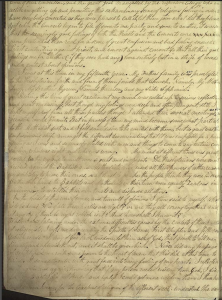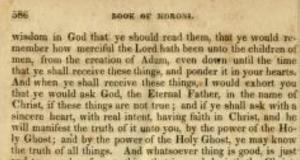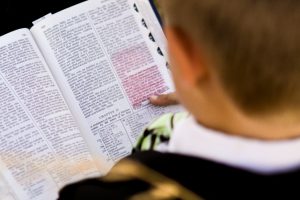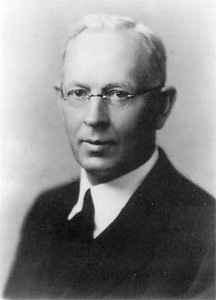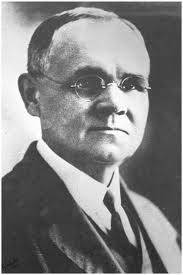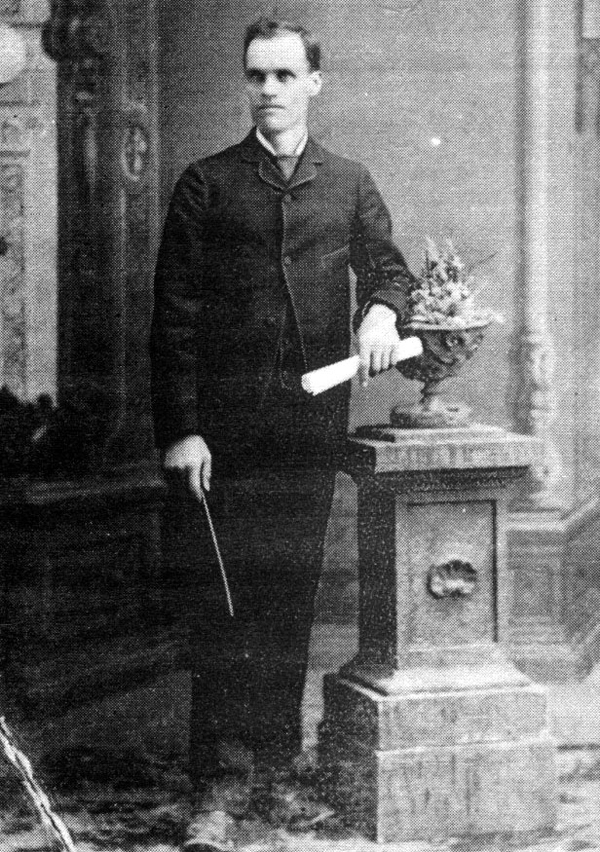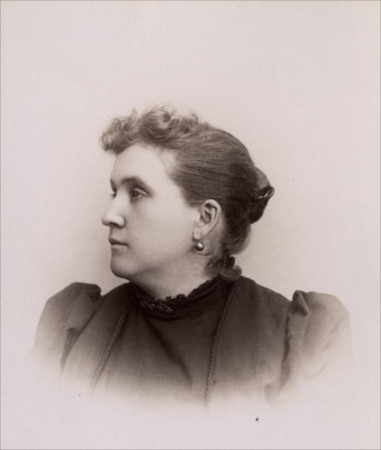There is a sacred grove about fifty feet from my office
It is in the atrium of the Joseph Smith Building on the campus of Brigham Young University. A bronze figure of teenage Joseph Smith is kneeling among the trees.
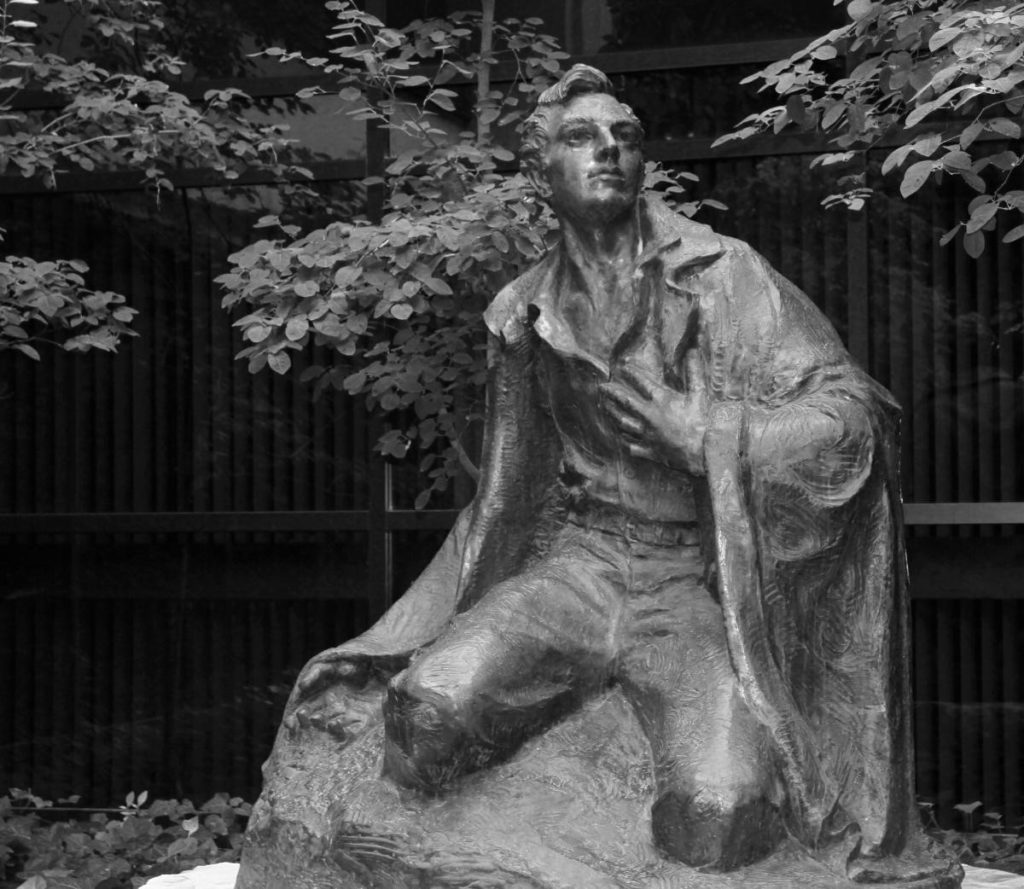
When Henry B. Eyring unveiled and dedicated this sculpture in 1997, he praised the artist for what Joseph’s heavenward gaze invites us to imagine. President Eyring said: “From studying the various accounts of the First Vision, we learn that young Joseph went into the grove not only to learn which church he should join but also to obtain forgiveness for his sins, something he seems not to have understood how to do.”
President Eyring hopes that every young person who sees the statue will relate to Joseph in the moment depicted, “that moment when Joseph Smith learned there was a way for the power of the Atonement of Jesus Christ to be unlocked fully.” According to President Eyring, “in more than one account the Lord addressed the young truth seeker and said, ‘Joseph, my son, thy sins are forgiven thee.’”[1]
Joseph’s parents “spared no pains” in teaching him “the Christian religion.”
They taught him that the scriptures “contained the word of God.” Joseph wrote that he was about twelve when he began to worry about the welfare of his immortal soul. His “all important concerns” led him to exercise faith in his parents’ teachings. He began searching the scriptures for himself, and doing what he called “applying myself to them.” That is how he discovered that various Christian churches professed things that the Bible did not.
Joseph grieved over that. He could see that contention characterized Christianity. He became deeply distressed because he believed the Christian teachings about his sinful and fallen state. He knew he needed to be redeemed by Jesus Christ, but “there was no society or denomination,” as far as he could tell, “that built upon the gospel of Jesus Christ as recorded in the New Testament,” he wrote, “and I felt to mourn for my own sins and for the sins of the world.”[2]
Joseph took the welfare of his soul seriously
For a few years he thought about his problem and what he should do. He considered the option of giving up his faith in God, but he couldn’t. To him, the sun, moon, and stars testified that God lived, and lived by divine laws, and should be worshipped. “Therefore,” Joseph wrote, “I cried unto the Lord for mercy, for there was none else to whom I could go.”[3]
Joseph chose a powerful verb in cried. He cried to the Lord for mercy because he was losing hope. There was no one else to extend him mercy. So he cried because he believed, or at least hoped, that the Lord would be merciful to him.
As President Eyring demonstrated, there is value in learning from Joseph’s various accounts of his vision
They tell us that Joseph believed his parents’ teachings about Jesus Christ. He searched the scriptures and believed that they contained the word of God. He applied himself to them. He worked hard to understand them and to discover what he should do because of them. He became intimately acquainted with people who believed different things about Christ. He paid attention to what they believed and how they behaved. For a few years he read, observed, and pondered. He thought about what he was becoming. He mourned when there was conflict between what he believed he should be and what he was. He became “exceedingly distressed” when he realized he was at an impasse. He was guilty of sin, and he could find no church built on the gospel of Jesus Christ, who redeemed people from their sins. So he cried out to the Lord for mercy.[4]
One of the best things Joseph did was balance urgency and caution
He recognized that he needed knowledge and power from God. Learning how to get it became his priority. “Information was what I most desired,” he said, and he formed a “fixed determination to obtain it.” He said it was “of the first importance that I should be right in matters that involve eternal consequences.”[5] Joseph put first things first. He relentlessly sought the most important truths.[6] Because his “immortal soul” was at stake, he acted both urgently and deliberately.[7]
He did not make rash decisions or jump to conclusions. “I made it an object of much study and reflection,” he related.[8] “I kept myself aloof from all these parties,” he said, “though I attended their several meetings as often as occasion would permit.” By exercising faith in God, studying much, observing closely, yet remaining aloof, Joseph positioned himself to make informed decisions. He could see that “contradictory opinions and principles laid the foundation for the rise of such different sects and denominations.” Being deliberate helped Joseph remain above the partisan prejudices “too often poisoned by hate, contention, resentment and anger.”[9]
Joseph tested Methodism
“In process of time my mind became somewhat partial to the Methodist sect,” he said, “and I felt some desire to be united with them.” If the Methodist teachings were right, Joseph would be able to seek and receive God’s prevenient grace. That is, despite his fallen nature, Joseph would receive a gift of God’s power that would enable him to come to Christ and be saved by him. He would know if it worked because it would be joyful, overwhelmingly joyful. Joseph watched as people experienced that joy. He tried it himself. He wanted his own Methodist conversion experience. “He wanted to get Religion too wanted to feel & shout like the Rest but could feel nothing.”[10] So despite his desire to follow Methodism, Joseph kept seeking.
He realized that he was not able to discern by himself whether Methodists were right, or Presbyterians, or Baptists. Each made compelling, bible-based arguments. That confused, distressed, and perplexed Joseph.[11] He sought more evidence before making a decision with eternal consequences.
What did he do when experts offered conflicting, consequential choices?
He kept his faith. He worked hard. He turned to the scriptures. He received a revelation. Then he acted on it. “While I was laboring under the extreme difficulties caused by the contests of these parties of religionists,” he said, “I was one day reading the Epistle of James, First Chapter and fifth verse.” The scripture taught him ask God directly and with faith. That was a revelation to Joseph, “like a light shining forth in a dark place.”[12] Before he read and reflected on it, he felt paralyzed. After, he knew what to do.
“I must do as James directs,” he said, “that is, Ask of God.” Joseph chose the word determination to describe his resolve to act on the scripture.[13] He used it twice in his history. Another time he called it “a fixed determination.”[14] Joseph was not passive. He resolved to act in faith and do something he had never tried before. He said, “I just determined I’d ask him.” He went to the woods to take the next step in his quest for God’s redeeming love.[15] Joseph knelt and “began to offer up the desires of my heart to God.”
He had never prayed aloud before
Joseph barely got started, however, before he aborted. He called it “a fruitless attempt to pray.”[16]It felt like his tongue swelled. He could not speak. It sounded like someone was walking up behind him. He tried to pray again but failed. The noise seemed to come closer. He sprang up and turned toward it. There was nothing making the noise, nothing he could see anyway.
He knelt again and “called on the Lord in mighty prayer.”[17] Something seized him, “some power which entirely overcame me,” he said. It was “an actual being from the unseen world.” Joseph was shocked at its power.[18] Doubts filled his mind.[19] Thick darkness enveloped him. He felt doomed. He was ready to give up, “to sink into despair and abandon myself to destruction,” he said. He chose not to do so, however. He chose instead, at that moment, to exert all his “powers to call upon God to deliver me out of the power of this enemy.”
Just then Joseph saw a brilliant light descending from above
He called it a “pillar of flame.” As soon as it appeared the darkness left. The spirit of God filled Joseph, replacing the feeling of despair. Unspeakable joy replaced doom. Joseph heard his name. He looked into the light and saw God, who introduced Joseph to His Beloved Son. Joseph saw Jesus Christ, standing in the air with his Father. “Joseph,” the Savior said, “thy sins are forgiven.” He continued, “I am the Lord of glory. I was crucified for the sins of the world that all those who believe on my name may have eternal life.”[20]
Once he could speak, Joseph asked if he should join the Methodists. “No,” came the answer.[21] None of the current Christian churches had God and Christ right because of confusing creeds. The creeds were philosophical statements about God that ruled out even the possibility that Heavenly Parents created children, including a Beloved Son, from preexisting intelligence and element as part of a plan to empower and exalt them until the children were fully like their parents. Joseph listened and learned that “Jesus Christ is the son of God.” He was crucified for sinners. He forgives the repentant and gives them eternal life. He can stand next to His Father, and not just in heaven. They can visit in person. They answer the prayers of anxious teenagers who ask in faith.
Joseph applied what he learned
He put his faith in the crucified and resurrected Savior who had atoned for his sins, and repented. Joseph knew what to do later when he realized “that I had not kept the commandments.” Every time he “fell into transgressions and sinned in many things,” he went back to his knees, chose hope over despair, and acted on the knowledge he had successfully tried before. He trusted the Savior who was crucified for him and “repented hartily for all my sins.”[22] That worked every time.[23]
Primary General President Joy D. Jones taught, “we can draw principles of truth from the Prophet Joseph’s experiences that provide insights for receiving our own revelation.” She noted these examples of good practice: “We labor under difficulties. We turn to the scriptures to receive wisdom to act. We demonstrate our faith and trust in God. We exert our power to plead with God to help us thwart the adversary’s influence. We offer up the desires of our hearts to God. We focus on His light guiding our life choices and resting upon us when we turn to Him. We realize He knows each of us by name and has individual roles for us to fulfill.”[24] That works every time.
When he unveiled the sculpture of Joseph in the grove near my office, President Eyring testified: “Jesus is the Christ. He lives. I know He lives. I know Joseph Smith saw Him, and I know that because He lives and because Joseph Smith looked up and saw Him and because He sent other messengers, you and I may have the thing that the Prophet Joseph wanted as he went to the grove: to know, not just to hope, that our sins can be washed away.”[25]
[1] Henry B. Eyring, “Remarks Given at the Unveiling Ceremony of ‘The Vision,’” Religious Education History, Brigham Young University, 66–68.
[2] “History, circa Summer 1832,” pages 1-2, The Joseph Smith Papers, accessed April 10, 2020, https://www.josephsmithpapers.org/paper-summary/history-circa-summer-1832.
[3] “History, circa Summer 1832,” pages 2-3, The Joseph Smith Papers, accessed April 10, 2020, https://www.josephsmithpapers.org/paper-summary/history-circa-summer-1832.
[4] “History, circa Summer 1832,” pages 2-3, The Joseph Smith Papers, accessed April 10, 2020, https://www.josephsmithpapers.org/paper-summary/history-circa-summer-1832.
[5] “Journal, 1835–1836,” p. 23, The Joseph Smith Papers, accessed April 10, 2020, https://www.josephsmithpapers.org/paper-summary/journal-1835-1836/24.
[6] “Journal, 1835–1836,” p. 23, The Joseph Smith Papers, accessed April 10, 2020, https://www.josephsmithpapers.org/paper-summary/journal-1835-1836/24.
[7] “History, circa Summer 1832,” p. 2, The Joseph Smith Papers, accessed April 10, 2020, https://www.josephsmithpapers.org/paper-summary/history-circa-summer-1832/2.
[8] “History, circa 1841, fair copy,” p. 2, The Joseph Smith Papers, accessed April 10, 2020, https://www.josephsmithpapers.org/paper-summary/history-circa-1841-fair-copy/2. “History, circa 1841, draft [Draft 3],” p. 2, The Joseph Smith Papers, accessed April 10, 2020, https://www.josephsmithpapers.org/paper-summary/history-circa-1841-draft-draft-3/2.
[9] “Orson Hyde, Ein Ruf aus der Wüste (A Cry out of the Wilderness), 1842, extract, English translation,” The Joseph Smith Papers, accessed April 10, 2020, https://www.josephsmithpapers.org/paper-summary/orson-hyde-ein-ruf-aus-der-wste-a-cry-out-of-the-wilderness-1842-extract-english-translation/1.
[10] “Alexander Neibaur, Journal, 24 May 1844, extract,” p. [23], The Joseph Smith Papers, accessed April 10, 2020, https://www.josephsmithpapers.org/paper-summary/alexander-neibaur-journal-24-may-1844-extract/1.
[11] “History, circa Summer 1832,” p. 2, The Joseph Smith Papers, accessed April 10, 2020, https://www.josephsmithpapers.org/paper-summary/history-circa-summer-1832/2. “History, circa June 1839–circa 1841 [Draft 2],” p. 3, The Joseph Smith Papers, accessed April 10, 2020, https://www.josephsmithpapers.org/paper-summary/history-circa-june-1839-circa-1841-draft-2/3. “Journal, 1835–1836,” p. 23, The Joseph Smith Papers, accessed April 10, 2020, https://www.josephsmithpapers.org/paper-summary/journal-1835-1836/24.
[12] “Appendix: Orson Pratt, A[n] Interesting Account of Several Remarkable Visions, 1840,” p. 4, The Joseph Smith Papers, accessed April 10, 2020, https://www.josephsmithpapers.org/paper-summary/appendix-orson-pratt-an-interesting-account-of-several-remarkable-visions-1840/4.
[13] “History, circa June 1839–circa 1841 [Draft 2],” p. 3, The Joseph Smith Papers, accessed April 10, 2020, https://www.josephsmithpapers.org/paper-summary/history-circa-june-1839-circa-1841-draft-2/3.
[14] “Journal, 1835–1836,” p. 23, The Joseph Smith Papers, accessed April 10, 2020, https://www.josephsmithpapers.org/paper-summary/journal-1835-1836/24.
[15] “History, circa June 1839–circa 1841 [Draft 2],” p. 3, The Joseph Smith Papers, accessed April 10, 2020, https://www.josephsmithpapers.org/paper-summary/history-circa-june-1839-circa-1841-draft-2/3.
[16] “Journal, 1835–1836,” p. 23, The Joseph Smith Papers, accessed April 10, 2020, https://www.josephsmithpapers.org/paper-summary/journal-1835-1836/24.
[17] “Journal, 1835–1836,” p. 24, The Joseph Smith Papers, accessed April 10, 2020, https://www.josephsmithpapers.org/paper-summary/journal-1835-1836/25.
[18] “History, circa June 1839–circa 1841 [Draft 2],” p. 3, The Joseph Smith Papers, accessed April 10, 2020, https://www.josephsmithpapers.org/paper-summary/history-circa-june-1839-circa-1841-draft-2/3. “History, circa 1841, draft [Draft 3],” p. 3, The Joseph Smith Papers, accessed April 10, 2020, https://www.josephsmithpapers.org/paper-summary/history-circa-1841-draft-draft-3/3.
[19] “Orson Hyde, Ein Ruf aus der Wüste (A Cry out of the Wilderness), 1842, extract, English translation,” The Joseph Smith Papers, accessed April 10, 2020, https://www.josephsmithpapers.org/paper-summary/orson-hyde-ein-ruf-aus-der-wste-a-cry-out-of-the-wilderness-1842-extract-english-translation/1.
[20] “History, circa Summer 1832,” pages 2-3, The Joseph Smith Papers, accessed April 10, 2020, https://www.josephsmithpapers.org/paper-summary/history-circa-summer-1832/2.
[21] “Alexander Neibaur, Journal, 24 May 1844, extract,” p. [23], The Joseph Smith Papers, accessed April 10, 2020, https://www.josephsmithpapers.org/paper-summary/alexander-neibaur-journal-24-may-1844-extract/1.
[22] “Journal, 1835–1836,” p. 24, The Joseph Smith Papers, accessed April 10, 2020, https://www.josephsmithpapers.org/paper-summary/journal-1835-1836/25.
[23] “Journal, 1835–1836,” p. 24, The Joseph Smith Papers, accessed April 10, 2020, https://www.josephsmithpapers.org/paper-summary/journal-1835-1836/25. “Revelation, July 1828 [D&C 3],” p. 1, The Joseph Smith Papers, accessed April 10, 2020, https://www.josephsmithpapers.org/paper-summary/revelation-july-1828-dc-3/1. “Letter to Emma Smith, 6 June 1832,” p. [1], The Joseph Smith Papers, accessed April 10, 2020, https://www.josephsmithpapers.org/paper-summary/letter-to-emma-smith-6-june-1832/1. “Visions, 3 April 1836 [D&C 110],” p. 192, The Joseph Smith Papers, accessed April 10, 2020, https://www.josephsmithpapers.org/paper-summary/visions-3-april-1836-dc-110/1.
[24] President Joy D. Jones, “An Especially Noble Calling,” April 2020 General Conference: https://www.churchofjesuschrist.org/study/general-conference/2020/04/14jones?lang=eng.
[25] Henry B. Eyring, “Remarks Given at the Unveiling Ceremony of ‘The Vision,’” Religious Education History, Brigham Young University, 66–68.


